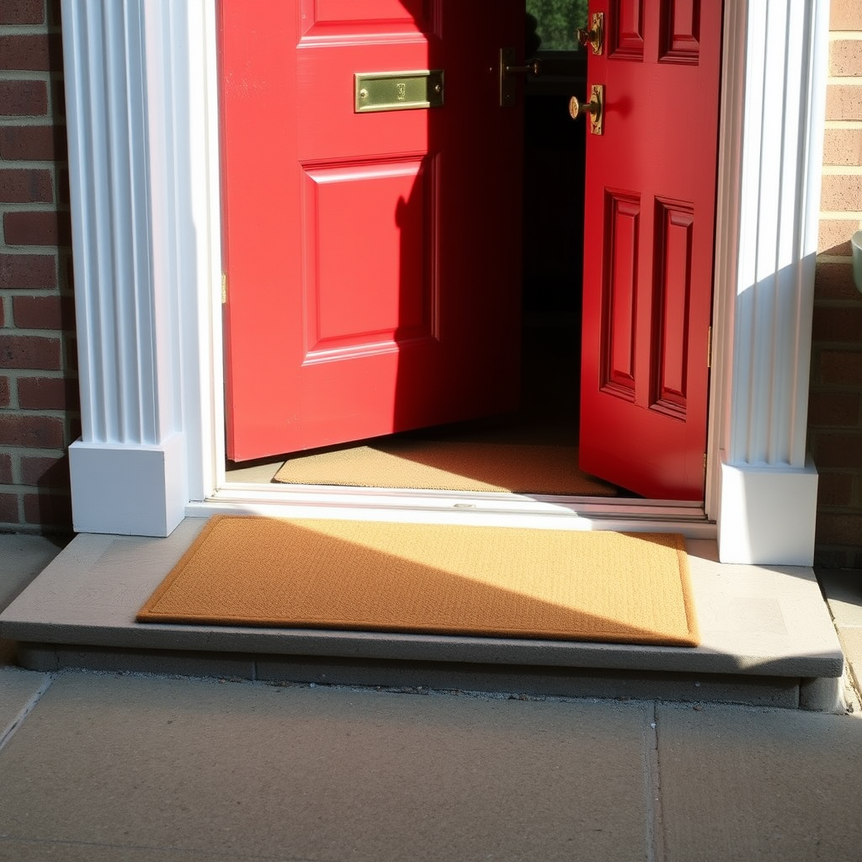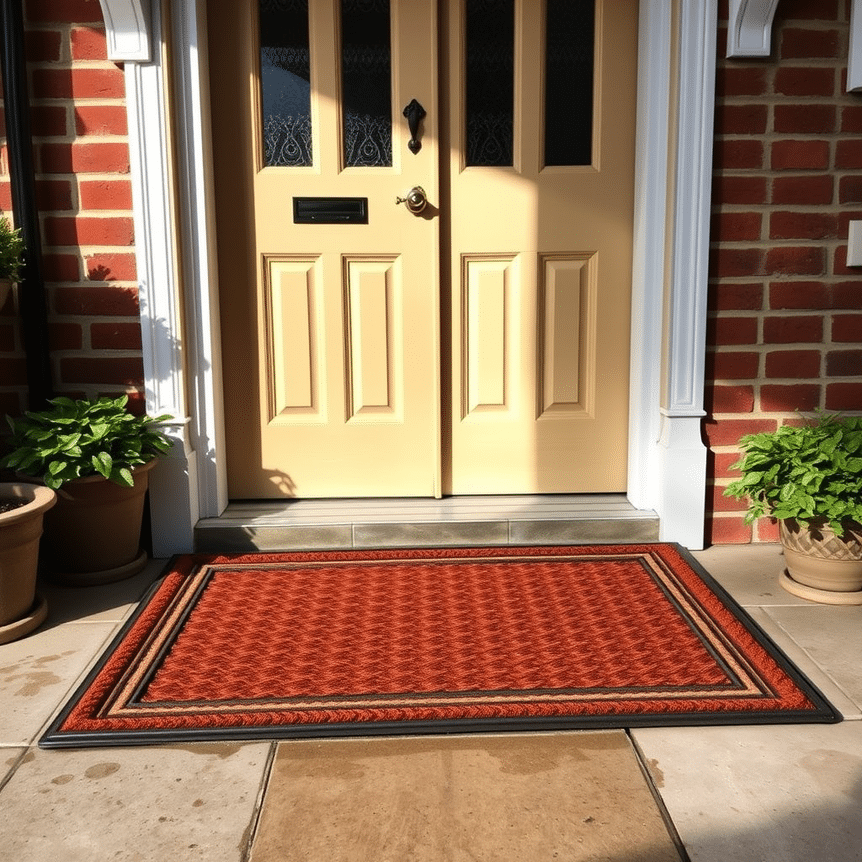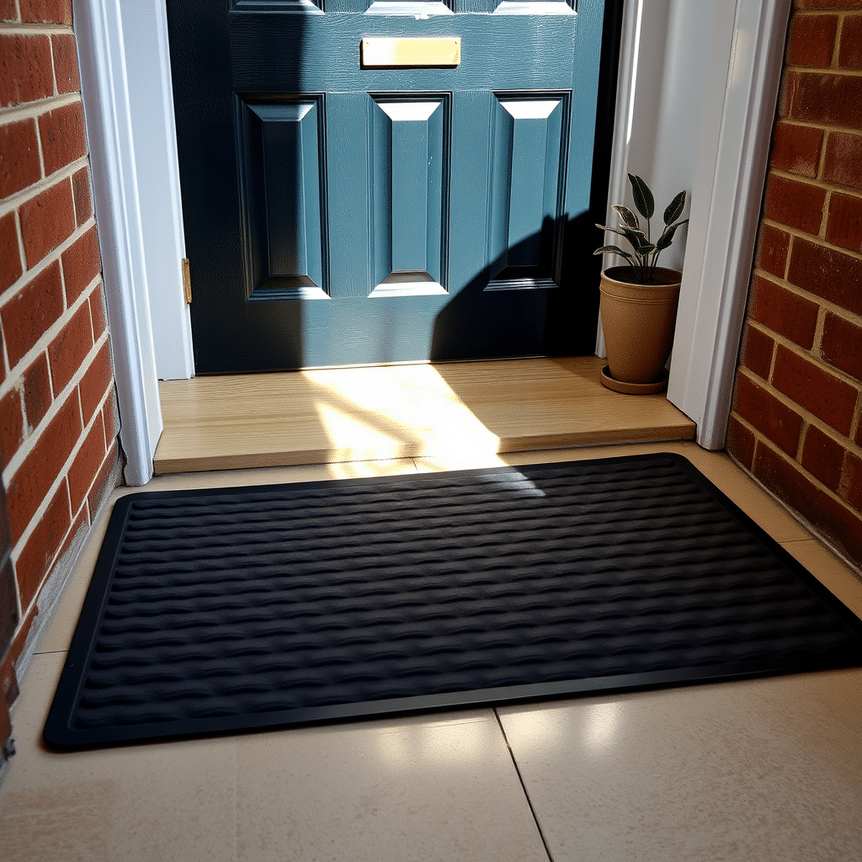Have you ever battled with a front door that stubbornly refuses to close properly? Or perhaps you’ve felt that annoying scrape as your door catches on your welcome mat? You’re not alone. According to a recent HomeOwners Alliance survey, over 43% of UK homeowners have experienced door clearance issues when selecting entryway mats – a problem easily solved with the right thickness knowledge.
Common Door Clearance Challenges Caused by Doormat Thickness
Too-thick doormats are a surprisingly common culprit behind door malfunctions in UK homes. When a mat exceeds your door’s clearance gap, you may encounter:
- Doors scraping against mats causing paint chipping and noisy opening/closing
- Doors failing to close fully, risking drafts, poor insulation, and security issues
- Increased wear on door bottoms and thresholds from repeated forceful closing
- Accessibility barriers, especially in homes with wheelchair users or mobility aids
- Warping or damage exacerbated by damp or swollen doormats in wet seasons
These issues are especially prevalent in older UK properties with smaller door clearances or installations with traditional thresholds, highlighting why precise doormat thickness is essential for smooth door operation.
Understanding Why Doormat Thickness Is Crucial for Smooth Door Operation
Your door’s bottom gap (clearance) is engineered to allow smooth door swings without obstruction. A doormat that exceeds this gap upsets that balance, forcing doors to push or drag over the mat. Not only does this make daily use frustrating, but it can also:
- Compromise the door’s weather seal, letting cold air and dampness in
- Increase energy costs as heating efficiency drops
- Damage door hardware from added strain
- Reduce lifespan of both doors and mats through excessive wear
A correctly matched doormat thickness ensures a seamless, quiet, and secure door operation year-round for UK homeowners.
Typical Door Clearance Dimensions in UK Homes (mm/cm with inches)
Across UK properties, door clearances vary but most fall within these common ranges:
- Standard modern doors: 12-19mm (1.2 to 1.9cm / 0.5 to 0.75 inches)
- Older Victorian/Edwardian properties: 15-25mm (1.5 to 2.5cm / 0.6 to 1 inch)
- Slim-profile interiors or flats: as low as 8-10mm (0.8 to 1cm / 0.3 to 0.4 inches)
Always remember these are bottom gaps—the space between the door edge and your floor or threshold. Accurate measurement of this door bottom gap is the first step to choosing the perfect entryway mat.
Step-by-Step Guide: Measuring Your Door Clearance Accurately
Accurate measurement is key when selecting the right doormat thickness:
- Ensure door is fully closed in its natural resting position.
- Take a standard UK credit card (0.76mm thick) and slide it under the door at midpoint.
- Add more cards one-by-one until you feel resistance.
- Multiply total cards by 0.76mm to get the gap measurement in millimetres.
- Subtract 2-3mm for practical clearance to avoid any rubbing.
Example: If 12 cards fit, 12 × 0.76mm = 9.12mm clearance. Deduct 3mm → max mat thickness ~6mm.
Tip: Measure at several points as floor/surface level may vary, especially in older homes.
Matching Doormat Thickness to Different Door Types for Optimal Fit
The ideal doormat thickness can significantly depend on the type of door you have:
Inward-Swinging Exterior Doors
- Recommended thickness: 8 to 12mm (0.3 to 0.5 inches), ideally at least 3mm thinner than the measured gap.
- Opt for a low profile door mat under 10mm for minimal friction and ease of opening and closing. These are particularly popular for front door applications.
Outward-Swinging Doors
- More lenient: mats up to 15-20mm (0.6 to 0.8 inches) are usually fine as the mat isn’t directly pushed by the door.
- Prioritize durability for outdoor use in rainy British climates, as these mats are fully exposed to the elements.
Internal Doors
- Often have tighter clearance (8-10mm); select mats under 8mm thickness.
- Low profile mats improve accessibility and prevent snagging, especially important for seamless transitions between rooms.
Quick Reference: Doormat Thickness Guide for Various UK Door Types
To help you quickly determine the best fit for your home, here’s a summary table:
| Door Type | Typical UK Clearance (approx.) | Recommended Max Mat Thickness | Key Considerations for UK Homeowners |
|---|---|---|---|
| Inward-Swinging Exterior Doors | 12-19mm | 8-12mm (at least 3mm less than gap) | Low profile mats under 10mm are ideal to prevent friction and ensure full closure. Essential for security and insulation. |
| Outward-Swinging Doors | 15-20mm+ | Up to 15-20mm | More forgiving on thickness. Focus on durability and weather resistance for outdoor conditions. |
| Internal Doors | 8-10mm | Under 8mm | Often tighter clearances. Low profile is crucial for smooth opening and accessibility, preventing snagging on carpets or flooring. |
| Older UK Properties (e.g., Victorian/Edwardian) | 15-25mm (variable) | Typically <10mm (low profile often best) | High thresholds and inconsistent floor levels common. Precise measurement is vital; a thin, flexible mat is often safest. |
| Homes with Underfloor Heating | Can be reduced due to raised floor | Low profile (<10mm) | Underfloor heating systems can subtly raise floor levels, thereby reducing the available door clearance. Measure carefully. |
Identifying When a Low Profile Door Mat Is the Best Solution
Certain UK home situations practically demand a low profile door mat (under 10mm thickness) to ensure proper door clearance and ease of use:
- Victorian and Edwardian houses with original high thresholds and naturally limited clearance, where traditional welcome mats might cause issues.
- Properties with underfloor heating which raises floor levels, subtly reducing the door gap.
- Homes requiring wheelchair or mobility aid access to maintain smooth, trip-hazard-free floor transitions.
- Homes with sliding or patio doors common in conservatories, where clearance is inherently minimal.
Choosing a low profile mat avoids daily door jams, reduces wear on your front door, and enhances overall accessibility.
How Doormat Materials Influence Thickness and Door Clearance
Thickness ratings alone don’t tell the full story—material compressibility greatly affects actual clearance needs, especially for entryway mats:
Coir Mats (natural fibre)
Popular in UK entryways for their traditional look and excellent scraping ability, coir mats compress by 20-30% underfoot. This means you should allow extra door clearance beyond their stated thickness to accommodate this compression and potential swelling from dampness. The British Weaving Association studies show that compressed coir mats may feel thicker than rubber mats of similar specs, affecting door clearance unexpectedly.
Rubber or PVC-backed mats
These mats maintain a more consistent, firm thickness. However, be cautious with mats over 15mm, as they can still become significant trip hazards or effectively block your door. Their stability makes them a good choice for outdoor areas or high-traffic zones.
Fabric or woven mats
These materials, such as cotton, polypropylene, or synthetic blends, can compress significantly. It’s crucial to measure their actual thickness with pressure applied to accurately estimate door clearance needs. They often excel indoors for absorbency and comfort.
Frequent Errors to Avoid When Selecting Doormat Thickness
To prevent common pitfalls and ensure your new welcome mat functions perfectly, avoid these mistakes:
- Measuring door gap with door open: Doors naturally drop slightly when closed—always measure only when fully shut to get an accurate door bottom gap measurement.
- Ignoring seasonal wood expansion: Wooden doors in damp British weather can swell by 1-2mm, reducing effective clearance. Factor this into your measurements for long-term suitability.
- Choosing mats by style alone: Beautiful, thick mats (30mm+) often won’t fit standard UK door clearances, leading to frustrating door malfunctions.
- Not factoring in door sweeps: Many UK doors have built-in draught excluders or brushes, which further reduce the available clearance. Always check.
- Overlooking surface types: Thick carpets or existing rugs affect the required mat thickness differently than hard floors. Always measure the gap from the top of your existing flooring.
Essential Takeaways for Choosing the Right Doormat Thickness
Armed with this guide, you’re ready to make an informed choice for your home’s entryway mat:
- Measure your door clearance properly with cards or similar tools while the door is closed.
- Select mats at least 2-3mm thinner than your measured clearance for hassle-free door operation.
- Choose a low profile door mat for most UK front doors, especially in older or tight-clearance homes.
- Account for material compression, especially with coir and fabric mats, as they may feel thicker in use.
- Consider your door type and swing direction when deciding maximum thickness.
- Plan for UK weather conditions: try combining a thin outdoor mat with a thicker indoor rug to manage both mud and moisture effectively.
- Test samples in situ before committing to avoid door damage or inconvenience, especially if you’re unsure about your door clearance.
For durable, stylish, and perfectly dense low profile mats suitable for UK homes, explore options like this non-slip low profile door mat. It balances sleek design with functionality—ideal for tight clearances and ensuring a welcoming, unobstructed entrance.
FAQ – Low Profile Door Mats & Door Clearance
- Q1: What is a low profile door mat?
- A low profile door mat is a welcome mat with a thickness generally under 10mm (0.4 inches) designed specifically to fit snugly under doors without causing jams or scraping, ensuring smooth door operation.
- Q2: Can I use a thick coir mat outside in the UK?
- Yes, coir mats are popular for outdoor use in the UK due to their excellent scraping properties. However, ensure your door clearance exceeds the mat thickness plus its compression allowance (add approximately 25%). If not, opt for a thinner or more flexible material to prevent door malfunctions.
- Q3: How do seasonal changes affect door clearance in the UK?
- Wooden doors, common in UK properties, tend to swell in damp British weather, which can reduce your existing door clearance by 1-2mm. Always account for this potential reduction when choosing your doormat thickness to avoid seasonal door jams.
- Q4: Should I get different mats for indoors and outdoors?
- Many UK homeowners find it beneficial to use a thinner, low profile mat outside for initial dirt scraping and to ensure proper door clearance, combined with a thicker, more absorbent mat just inside the door to trap fine moisture and dirt, maintaining cleaner floors.
- Q5: How do I prevent door damage from thick mats?
- To prevent door damage caused by an incompatible doormat thickness, always measure your door clearance accurately while the door is closed. Then, select a mat that is at least 2-3mm thinner than this adjusted gap. Prioritising a low profile door mat can also significantly reduce the risk of wear and tear on your front door and threshold.



